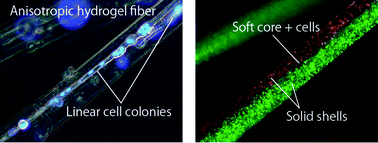Hydrogel materials with microscale heterogeneity are of great interest in the effort to spatially control cellular microenvironments in tissue engineering applications. Here we present a microfluidic system to continuously synthesize chemically and physically anisotropic Ca–alginate hydrogel microfibers enabling the guidance of cell proliferation to form linear cell colonies and intracellular networks. The microfluidic gelation process involves 2 critical steps to obtain alginate microfibers using axisymmetric microchannels with uniform depth: introduction of a buffer solution between the sodium alginate (NaA) and CaCl2 solutions to modulate the gelation speed, and use of a thickener to balance the viscosities of the solutions. We synthesized hydrogel fibers with diameters of ∼7 to 200 μm, maintaining the anisotropy in the cross-section, and examined factors affecting the fiber diameter and uniformity. Moreover, parallel alginate flows with and without propylene glycol alginate (PGA) enabled the formation of sandwich-type solid-soft-solid hydrogel fibers, which were used to guide the direction of growth of cells inoculated in the soft-core, with the help of outer polycation membranes made of poly-L-lysine. We demonstrated the formation of linear colonies of 3T3 and HeLa cells inside the anisotropic fiber and observed elongated nuclei along the fiber direction. In addition, the heterogeneous morphology of the fiber was utilized to guide neurite elongation and generate cellular networks by using neuron-like PC12 cells. The hydrogel fibers reported here can be used as an innovative tool for investigating cell and tissue morphogenesis in heterogeneous microenvironments, and for creating tissue models with precise control of cellular alignment and elongation.

You have access to this article
 Please wait while we load your content...
Something went wrong. Try again?
Please wait while we load your content...
Something went wrong. Try again?


 Please wait while we load your content...
Please wait while we load your content...